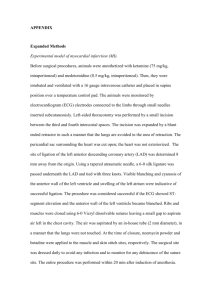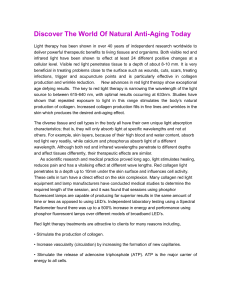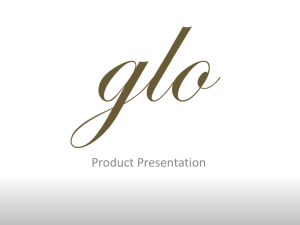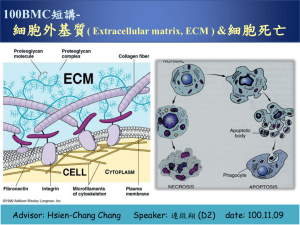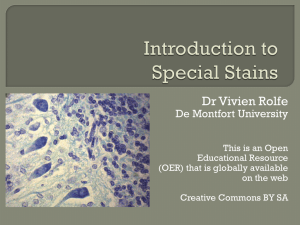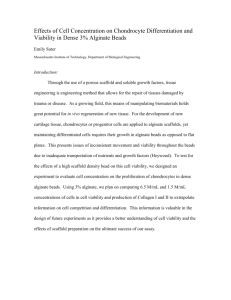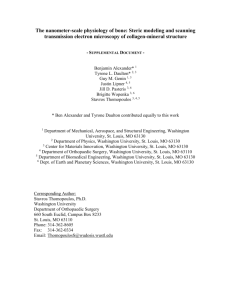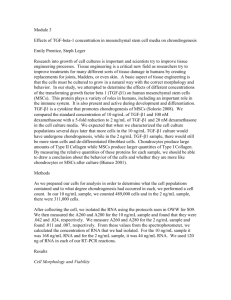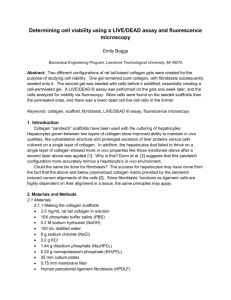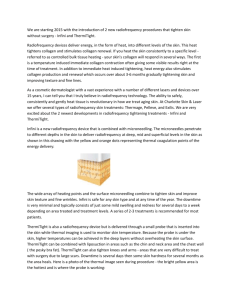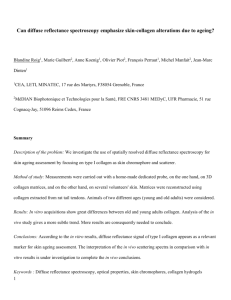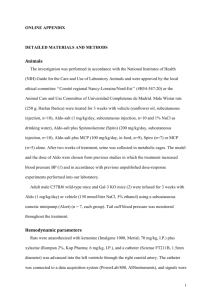appendix
advertisement
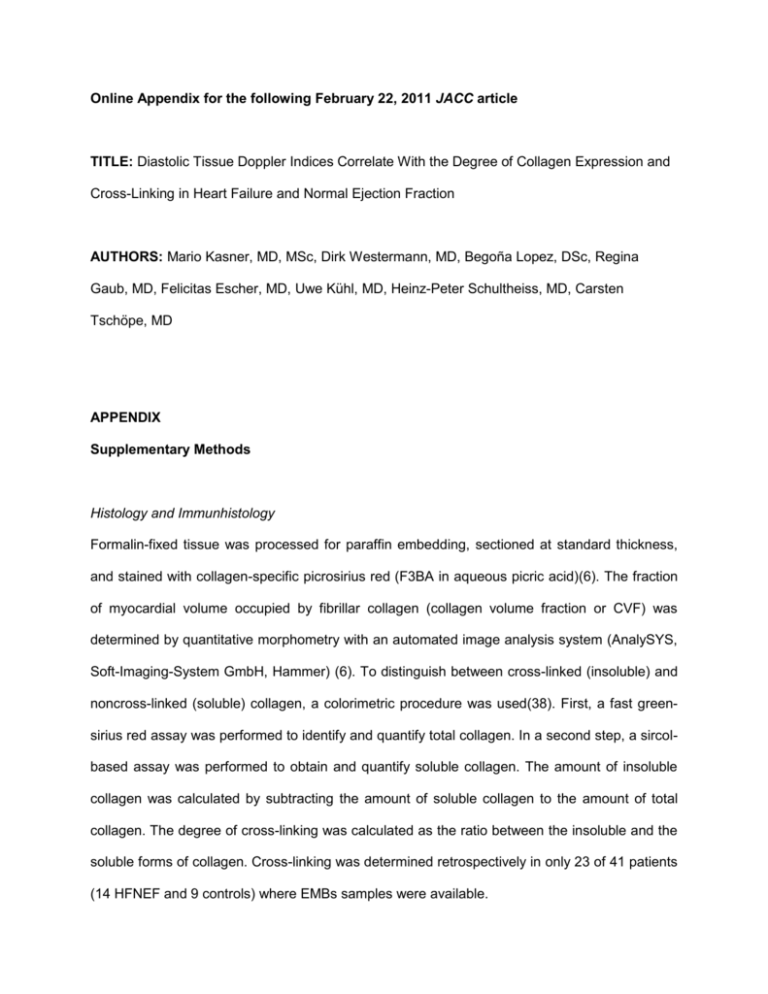
Online Appendix for the following February 22, 2011 JACC article TITLE: Diastolic Tissue Doppler Indices Correlate With the Degree of Collagen Expression and Cross-Linking in Heart Failure and Normal Ejection Fraction AUTHORS: Mario Kasner, MD, MSc, Dirk Westermann, MD, Begoña Lopez, DSc, Regina Gaub, MD, Felicitas Escher, MD, Uwe Kühl, MD, Heinz-Peter Schultheiss, MD, Carsten Tschöpe, MD APPENDIX Supplementary Methods Histology and Immunhistology Formalin-fixed tissue was processed for paraffin embedding, sectioned at standard thickness, and stained with collagen-specific picrosirius red (F3BA in aqueous picric acid)(6). The fraction of myocardial volume occupied by fibrillar collagen (collagen volume fraction or CVF) was determined by quantitative morphometry with an automated image analysis system (AnalySYS, Soft-Imaging-System GmbH, Hammer) (6). To distinguish between cross-linked (insoluble) and noncross-linked (soluble) collagen, a colorimetric procedure was used(38). First, a fast greensirius red assay was performed to identify and quantify total collagen. In a second step, a sircolbased assay was performed to obtain and quantify soluble collagen. The amount of insoluble collagen was calculated by subtracting the amount of soluble collagen to the amount of total collagen. The degree of cross-linking was calculated as the ratio between the insoluble and the soluble forms of collagen. Cross-linking was determined retrospectively in only 23 of 41 patients (14 HFNEF and 9 controls) where EMBs samples were available. To determine collagen type I and III, immunohistological stainings were performed using standard techniques. The antibodies were purchased from Chemicon (anti-collagen type-I, 1:225 and type-III, 1:75). Immunohistochemical stainings were quantified by digital image analysis (DIA)(39). Basically, DIA macros consisted of: 1)grabbing of the image; 2)recognition of artifacts for the calculation of the net myocardial area (Heart Area/HA= area of measurement frame – lit area/mm2); 3) recognition of stained collagen (red, yellow and green) under polarized light. The data evaluated by these LUCIA macros (LUCIA-Gv.3.52ab, Nikon GmbH,Germany) were transferred to a Microsoft Excel data processing macro, which calculated the net 'Heart Area' (HA) and the means of measured qualities (Area Fraction=AF). In addition, the expression of lysyl oxidase (LOX), the enzyme responsible for collagen cross-linking was determined retrospectively in 15 patients where EMBs samples were available (10 HFNEF and 5 controls). Immunhistochemical analysis for LOX was performed on formalinfixed and paraffin-embedded sections, and staining was performed by the avidin-peroxidaselabeled dextran polymer method. Positive staining was visualized with DABPlus (Boehringer Mannheim Corp.), and tissues were counterstained with Harris hematoxylin (Sigma). A mouse monoclonal antibody against LOX (R&D Systems) was used as the primary antibody. The results are expressed as semiquantitative values (absent, mild, moderate and intense expression). The histomorphological study was performed by a pathologist blinded for patient data. To determine myocyte dimensions the maximal myocyte diameter was measured through the nucleus from 10 cells per sample. Using standard equation for sample size, 10 measurements reduced the sampling error to <3%. RNA isolation, reverse transcription Total RNA was extracted from the EMB by the Trizol-method (GIBCO BRL, Carlsbad, California). Additional purification was performed using the ChargeSwitch® Total RNA Cell-Kit (Invitrogen, Karlsruhe,Germany). The yield of purified total RNA was analyzed by checking the UV absorbance at 260 nm on the NanoDrop® ND-1000 spectrophotometer (Agilent Technologies, Boeblingen,Germany). Reverse transcription from 30µl of total RNA was carried out using the High Capacity cDNA Archive-Kit (Applied Biosystems/ABI, Darmstadt, Germany) to a final volume of 60µl according to the manufacturer’s instructions. Preamplification and RT-PCR The ABI inventory TaqMan® gene expression assays (including forward and reverse primers, and fluorescently marked probe) are used for preamplification and for the real-time-PCR (RTPCR) according to the manufacturers’ protocol. Prior to RT-PCR, 1-250ng of cDNA samples was preamplified with the pooled gene expressions assays using TaqMan® PreAmp Master Mix (Early access) in a final volume of 25µl. The PCR program consisted of 10min denaturation step at 95°C following by 14 cycles each of 4min at 60°C and 15sec at 95°C. The preamplification products were diluted 1:20 with undiluted TE-buffer (10mM Tris/HCl pH 7.5, 1mM EDTA). 2µl of diluted cDNA were used for the RT-PCR. RT-PCR was performed with TaqMan® Universal PCR Master Mix according to the manufacturers’ protocol. The PCR reactions prepared without cDNA were transferred to a Thermo-Fast® 96 Detection Plate (ABgene, Hamburg,Germany) and then 2µl of preamplified cDNA were added to each well. Plates were sealed with a MicroAmp™ Optical Adhesive Film (ABI, Darmstadt, Germany). The PCR was run on an ABI7900 HT Fast RT-PCR System (Applied Biosystems, Darmstadt, Germany) with the following program: hot start at 50°C for 2min, denaturation at 95°C for 10min and 40 cycles of amplification (95°C for 15sec and 60°C for 1min). Quantification of housekeeping CDKN1B transcripts as an internal control for the amount and quality of cDNA was undertaken for all samples.

